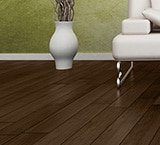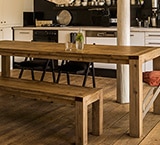Caring for Wood Floors in your home doesn't stop at the mop, and helps them last for many years. Some historic homes, well over a century old, still have their original hardwood. Maintaining it through proper cleaning and protection prevents several types of damage, such as warping, discoloration and cracking.
REMOVING DUST AND DIRT
Dust and dirt can scratch wood floors, damaging the surface and eventually the wood grain. Avoid wearing shoes indoors to keep this debris to a minimum. Keep a bench and shoe shelf at entrances to make it easy to remove them when anyone walks in. Whether or not you wear shoes indoors, however, caring for wood floors properly means you will need to vacuum and dust mop them. Consider doing this twice a week, and if you do wear shoes in the house, vacuum the hardwood daily in high-traffic areas.
AVOIDING WATER DAMAGE
Water can warp wood floors, penetrating into the seams of each plank and causing them to swell. Over time, this can discolor the flooring and also crack it as it dries. Although it's tempting to use water for quick cleanups and deeper cleaning, you should only use it as part of a mixture that includes wood cleaning products, such as Murphy® Oil Soap. When using a cleaning mix, wring the mop thoroughly until it feels only damp, and clean up any areas that do collect puddles right away. Keep in mind humidity may also pose a problem if you live in a dry or humid climate. In either case, use a humidifier or dehumidifier to keep your air's moisture between 30 and 50 percent.
Keeping Floors Sealed
A sealant protects and extends the life of wood flooring by protecting it from physical damage. Over time, however, the sealant itself will wear and need to be reapplied. Whether your floors carry water-based polyurethane, oil-based polyurethane or a wax coating, check occasionally to see if it will need to be refinished. This should happen with a dose of sanding every seven to 10 years, according to Real Simple, though this depends on the amount of traffic, type of sealant (waxed floors may need as often as once a year) and the species of wood used for your flooring.
MINDING THE ELEMENTS
Wood floors often suffer from too much sun and heat. Specifically, direct exposure to UV rays can weaken the surface and discolor the finish. "Hot spots" may also occur, especially in more intense light during the afternoon. Using blinds, shades or curtains to block some of this sun will help protect your floors and soften the appearance of the room at the same time.
MASTERING YOUR SPACE
Use rugs in high-traffic areas to protect the floor. Those placed outside of the home's entrances pick up debris that would normally come into the home and onto the floor. Rugs also protect areas that are exposed to sunlight and prone to scratches from furniture.
Choose cleaners formulated for hardwood, as well. Acidic cleaners, all-purpose solutions and other harsh chemical-based products can damage the surface of the flooring. And for the quick and dry tasks, keep a clean, soft dust mop available. Dust mops with removable, washable pads work great for picking up everyday dust and dirt.
When caring for wood floors, follow a regular cleaning schedule. Vacuum a few times a week a deep cleaning once a month usually takes care of any grime that survives these sessions. Spot clean as needed to remove spills, gunk and food. And when your floors start to appear dull from a worn finish, contact a floor refinisher for advice on applying new sealant.
This article was brought to you by Colgate-Palmolive Company, the makers of Murphy® Oil Soap. The views and opinions expressed by the author do not reflect the position of the Colgate-Palmolive Company.











